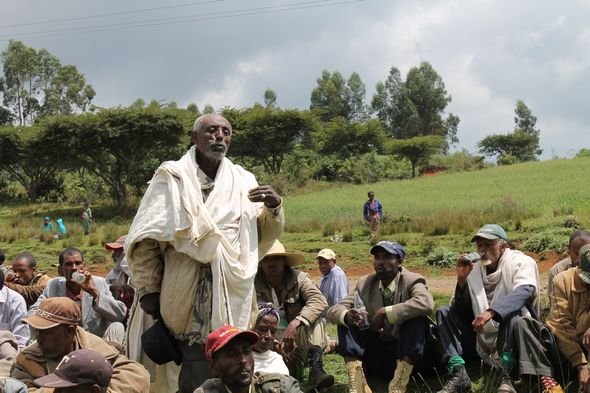Learning to deliver on their promise in Africa
Irrigated agriculture has once again risen to prominence among sub-Saharan Africa’s development priorities, after a long lull prompted by disappointment in the results of major investments during the 1970s and 1980s. This time, however, rising concern about the impacts of climate change on vulnerable rainfed agriculture lend special urgency to the task of expanding irrigation. Without it, Africa’s food security will likely continue to prove elusive and so will the increased resilience that farmers need to cope with climate change and other stresses.

Photo credit: Tadesse Desalegne
If irrigated agriculture is to succeed in Africa, then so must the institutions needed for its efficient management. Such institutions are important for both the centralized systems that have predominated until recently as well as for the various informal and private types that are now emerging. During previous rounds of investment, donor agencies bet heavily on local water user associations (WUAs) in an effort to decentralize irrigation management. WUAs seemed like just the right solution during the 1980s-1990s, a time when governments were striving to reduce public roles and expenditures in compliance with structural adjustment policies.
Theory meets practice
WUAs are formal organizations created to bring together farmers (usually no more than a few hundred) for the purpose of managing a shared irrigation system. While Africa’s experience with them has been decidedly mixed and sometimes disappointing, a dozen or so countries have gained much experience and insight, which provide a solid basis for improvement. This is the spirit in which the International Water Management Institute (IWMI) has published a new study, Water User Associations: A Review of Approaches and Alternative Management Options for Sub-Saharan Africa (Working Paper 180), which was prepared with support from the International Fund for Agricultural Development (IFAD).
The paper critically examines the expectations that drove investment in WUAs, finding a significant gap between the theory and actual practice on the ground. Created in response to the perceived failings of state-managed irrigation systems, WUAs were intended to meet two conditions considered important for improved irrigation performance. The first is collection of fees to cover the costs of operation and maintenance, giving rise to a stronger sense of ownership as well as greater efficiency and accountability. The second is increased farmer participation in decisions, leading to more sustainable water use and more equitable sharing of the benefits.
For the most part, WUAs have fallen short of these expectations, which were probably not realistic to begin with. Most associations have not proved effective at cost recovery or become financially self-sustaining, nor have they turned out to be as participatory as hoped. Rather, they have tended to reflect gender as well as other socio-economic and political inequalities that already existed in rural communities. These limitations, in turn, have tended to short-circuit the WUAs’ “feedback loop,” in which more participatory management was supposed to result in improved irrigation and increased agricultural productivity, leading in turn to better cost recovery and more farmer participation.
Live and learn
Those conclusions underline the importance of setting aside the theory that underlies WUAs to better understand the conditions that shape their performance. The IWMI study points to four types of conditions, citing numerous case studies to explain and demonstrate the (1) social and economic contexts, (2) water resources, (3) governance arrangements, and (4) features of membership. The analysis demonstrates the striking diversity of conditions under which WUAs operate across sub-Saharan Africa and their uniqueness by comparison with WUAs in North Africa and Asia.
Recognizing these differences as well as shortcomings in the performance of so-called “mainstream” WUAs, government policy makers and donors have experimented with various types of improvements. These range from legal and contractual adjustments to training as well as monitoring and evaluation. They have not proved capable, however, of fundamentally improving the effectiveness of the WUAs or altering the basic conditions that influence their performance.
Beyond the mainstream
The study offers seven alternative approaches that address the issues of cost recovery and farmer participation differently from the mainstream model:
- Participatory design – WUAs contribute to the design of irrigation infrastructure, selecting technologies that fit their financial and labor resources.
- Overarching water user platform – It brings together various WUAs to take part in decisions about water allocation across whole river basins.
- Multi-stakeholder and innovation platform – It provides a means for WUAs and others to share knowledge that can result in better irrigation management decisions.
- Joint management – Government agencies work closely with WUAs to support their participation in operating and maintaining the irrigation system.
- Multifunctional WUA – It develops other services besides water management, which generate income and help cover costs.
- Public-private partnership – The WUA enters into a contract with a private entity, which takes responsibility for delivering irrigation services.
- Combined surface water-groundwater WUA – By managing both water sources, the WUA gains greater flexibility, thus lessening its dependence on irrigation agencies.
Though well documented, none of these options has so far been widely adopted. Yet, they provide a good point of departure for continued efforts to improve irrigation governance in sub-Saharan Africa. On this basis, future projects can revisit the conventional WUA model, finding ways for local people to create the organization they need rather than having it imposed on them by outsiders. These efforts will require commitment and perseverance in the many places where smallholder farmers are eager to make the transition from uncertain but familiar rainfed farming to more resilient irrigated systems.
Read the report:
Aarnoudse, E.; Closas, A.; Lefore, N. 2018. Water user associations: a review of approaches and alternative management options for Sub-Saharan Africa. Colombo, Sri Lanka: International Water Management Institute (IWMI). 77p. (IWMI Working Paper 180).

